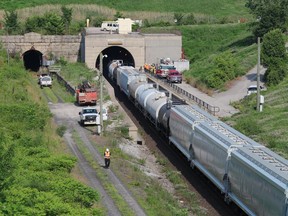A Transportation Safety Board of Canada report on a 2019 derailment in a Canada-US rail tunnel raises concerns about CN Rail safety and inspection processes, Sarnia’s mayor says.

A Transportation Safety Board of Canada report on a 2019 derailment in a Canada-US rail tunnel raises concerns about CN Rail safety and inspection processes, Sarnia’s mayor says.
Advertisement 2
Article content
“When you read that report, you really get concerned about the level of diligence going into the operation and equipment,” said Mike Bradley
Article content
The derailment happened about 4 am June 28, 2019, as a 140-car train was crossing the 1.9-kilometer tunnel under the St. Clair River from Sarnia to toward Port Huron, Mich.
An open-top bathtub gondola car, built in 1978 and historically used for transporting things such as coal, had been modified in 2012 to carry scrap steel, but years of wear and corrosion had caused defects that went undetected by inspection processes, including several inspections in the preceding 24 hours, the safety board report said.
Around 4:20 am, the left side of the scrap-filled car collapsed, leading to a 45-car derailment that included a spill of about 55,000 liters of sulfuric acid, the report said. A locomotive also derailed.
Advertisement 3
Article content
There were no injuries.
The Transportation Safety Board issued four advisories in the aftermath, including requiring railcar owners to have procedures to identify, inspect, and repair similar cars as needed.
Another required that all bathtub gondola cars built by Berwick Forge operating in North America be identified, located and examined to ensure their safety.
CN has inspected 416 such cars, the report says, noting 149 — or 36 per cent of those inspected — had defects.
Another 1,984 of the cars were not on the CN network and were to be inspected by other railways and/or car owners every two years, said the safety board’s Hugo Fontaine.
“Cars that fail inspections cannot remain in service,” Fontaine said by email.
Advertisement 4
Article content
“They must either be repaired to allow them to return to service or . . . scrapped, as decided by the car owner. Repaired cars must continue to be inspected every two years until they are retired from service.”
The safety board report noted structural defects in the car that caused the derailment were in several areas: “shear plates, stub sills, car body bolsters and side sills, as well as thinned-out steel sections due to corrosion.”
Defects included cracks, buckling and thinned-out sections, Fontaine said.
At the time of collapse, the maximum force exerted on the car — about 388,000 pounds — was about 61 per cent of what it should have been able to withstand, had it not deteriorated, the report said.

“You expect CN to have a level of diligence and inspection that would address some of those serious concerns,” said Bradley, noting that’s critically important given rail lines run through many cities and towns.
Advertisement 5
Article content
He recalled the 2013 Lac-Mégantic, Que., derailment disaster that killed 47 people.
“I thought we had moved beyond what seems to be some basic inspection stuff not happening,” he said, adding, “it’s a real wake-up call to CN and the industry that you better get your act together.”
Other TSB advisories following the 2019 derailment included ensuring specific instructions for emergency procedures following derailments in tunnels involving dangerous goods, and for “Transport Canada to ensure all railways have adequate practices in place to effectively manage in-train forces.”
Since the derailment, CN has installed alarms in the tunnel tp alert workers to toxic gases, and communicated new procedures for dealing with emergencies in tunnels to employees, a board release said.
Advertisement 6
Article content
Transport Canada also has recommended Canadian railways ensure equipment, procedures and instructions are reviewed and updated as required, it noted.
The safety board also has been in contact with the Association of American Railroads to ensure all relevant cars are inspected, it said.

Bathtub gondola cars and others are regularly “interchanged” between rail companies on both sides of the border, the report said.
“However, neither the Canadian freight car safety rules nor the US freight car safety standards contain limits for damage to significant freight car structure, such as buckled side posts, ruptured side sheets, end sheets, and tub sections; negative side sill camber; buckled top chords; or extensive cracking and corrosion,” the report said.
Advertisement 7
Article content
“Thus, the structural defects did not prohibit (the car that failed and caused the derailment) from being interchanged.”
There have been changes to interchange rules since the derailment to address “defects related to stub sills and side sills,” which are two main railcar structural elements, Fontaine said.
Despite being deteriorated, that car (identified as car DJJX 30478 in the report) traveled frequently within and between Canada and the US and was interchanged between railways 16 times in the six months before the derailment, the report said.
It also, in the three months before the derailment, received 24 certified car inspections at various CN line points, and underwent various other “pull-up” and “wayside” inspections “with no significant defects noted,” it said, adding the car had routine maintenance but no other work in the year before the derailment.
Advertisement 8
Article content
Bradley noted there also have been instances of CN failing to report derailments in the past.
“So, it’s a matter of trust,” he said.
“They are an important part of the community. . . here, but you expect them to operate at a level that says ‘We will put safety first.’”
A spokesperson noted CN, after the derailment, modified its inspection processes for “this specific car type.”
The Crown corporation also “continuously applies what it learns from incidents and events to advance safety, a core value at CN,” Daniel Salvatore said in an email, adding the cars are now subject to mandatory inspections.
Recommended from Editorial
Article content


